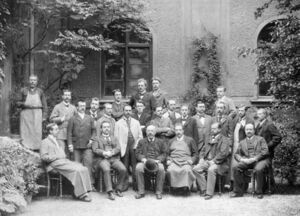يوهانس تيله (كيميائي)
فريدرش كارل يوهانس تيله Friedrich Karl Johannes Thiele | |
|---|---|
 | |
| وُلِدَ | مايو 13, 1865 |
| توفي | أبريل 17, 1918 (aged 52) |
| الجنسية | ألمان |
| المدرسة الأم | جامعة هاله |
| اللقب | أنبوب تيله |
| السيرة العلمية | |
| المجالات | كيمياء |
| الهيئات | جامعة ميونخ، جامعة ستراسبورگ |
| المشرف على الدكتوراه | ياكوب فولهارد |
| طلاب الدكتوراه | هاينرش أوتو ڤيلاند, ياكوب مايزنهايمر, هرمان شتاودنگر، أوتو ديمروت، السير روبرت پيكارد[1] |
فريدرش كارل يوهانس تيله Friedrich Karl Johannes Thiele (13 مايو 1865 - 17 أبريل 1918) كيميائي ألماني and a prominent professor at several universities, including those في ميونخ و ستراسبورگ. He developed many laboratory techniques related to isolation of organic compounds. In 1907 he described a device for the accurate determination of melting points,[2] since named Thiele tube after him.[3]
وُلِد تيله في Ratibor, پروسيا، now Racibórz, پولندا.[4] Thiele studied mathematics at the University of Breslau but later turned to chemistry, receiving his doctorate from Halle in 1890 . He taught at the University of Munich from 1893 to 1902, when he was appointed professor of chemistry at Strasbourg.[5]
He developed the preparation of glyoxal bis(guanylhydrazone).[6]
بعد اقتراح ككوليه for benzene structure in 1865, Thiele suggested a "Partial Valence Hypothesis", which concerned double and triple carbon-carbon bonds with which he explains their particular reactivity. In 1899 this led to the prediction of the resonance that existed in benzene, and he proposed a resonance structure, by using a broken circle to represent the partial bonds.[7] Later this problem was completely solved with the advent of quantum theory.
 المحاضر الخاص يوهانس تيله (الصف الأول، الثاني من اليسار) 1893 مع زملائه في LMU في ميونخ، ومنهم أدولف فون باير (الوسط) و ڤلهلم مانشوت (الوقوف، الثاني من اليسار) |
في 1899، كان تيله رئيس قسم الكيمياء العضوية في أكاديمية العلوم الباڤارية في ميونخ. With his associate Otto Holzinger, he synthesised an iminodibenzyl nucleus: two benzene rings attached together by a nitrogen atom and an ethylene bridge.[8]
He discovered the condensation of ketones and aldehydes with cyclopentadiene as a route to fulvenes. He also recognized that these deeply colored species were related to but isomeric with benzene derivatives.[9]
حسب أحد تلاميذه هاينرش أوتو ڤيلاند، Thiele had a dislike of the chemistry of natural products.[10]
. . . . . . . . . . . . . . . . . . . . . . . . . . . . . . . . . . . . . . . . . . . . . . . . . . . . . . . . . . . . . . . . . . . . . . . . . . . . . . . . . . . . . . . . . . . . . . . . . . . . . . . . . . . . . . . . . . . . . . . . . . . . . . . . . . . . . . . . . . . . . . . . . . . . . . . . . . . . . . . . . . . . . . . .
الهامش
- ^ Aftalion, Fred (1991). A history of the international chemical industry. Philadelphia: University of Pennsylvania Press. ISBN 978-0-8122-8207-8.
- ^ Thiele, Johannes (1907-01-01). "Ein neuer Apparat zur Schmelzpunktsbestimmung". Berichte der Deutschen Chemischen Gesellschaft (in الإنجليزية). 40 (1): 996–997. doi:10.1002/cber.190704001148. ISSN 1099-0682.
- ^ "Johannes Thiele". Zeitschrift für Angewandte Chemie. 31 (49): 117–118. 1918. doi:10.1002/ange.19180314901.
- ^ Fritz Straus (1927). "Obituary: Johannes Thiele (1865-1918)". Berichte der Deutschen Chemischen Gesellschaft. 60 (6): A75–A132. doi:10.1002/cber.19270600633.
- ^ Thiele, Friedrich Karl Johannes (1999). A Dictionary of Scientists. Vol. 1. Oxford: Oxford University Press. ISBN 9780192800862.
- ^ Freedlander, B.L.; French, Frederic A. (1958). "Carcinostatic Action of Polycarbonyl Compounds and Their Derivatives II. Glyoxal Bis(Guanylhydrazone) and Derivatives" (PDF). Cancer Res. 18 (3): 360–363. PMID 13523604.
- ^ Thiele, Johannes (1899) "Zur Kenntnis der ungesättigten Verbindungen" (On our knowledge of unsaturated compounds), Justus Liebig’s Annalen der Chemie,306: 87-142; see: "VIII. Die aromatischen Verbindungen. Das Benzol." (VIII. The aromatic compounds. Benzene.), pages 125-129.
- ^ Shorter, Edward (2005). A historical dictionary of psychiatry. New York: Oxford University Press. ISBN 978-0-19-517668-1.
- ^ Thiele, J. (1900). "Ueber Ketonreactionen bei dem Cyclopentadiën". Berichte der Deutschen Chemischen Gesellschaft. 33 (1): 666–673. doi:10.1002/cber.190003301113.
- ^ Bynum, Ed. W. F.; Porter, Roy, eds. (2006). "Friedrich Karl Johannes Thiele". The Oxford Dictionary of Scientific Quotations. Oxford: Oxford University Press.
